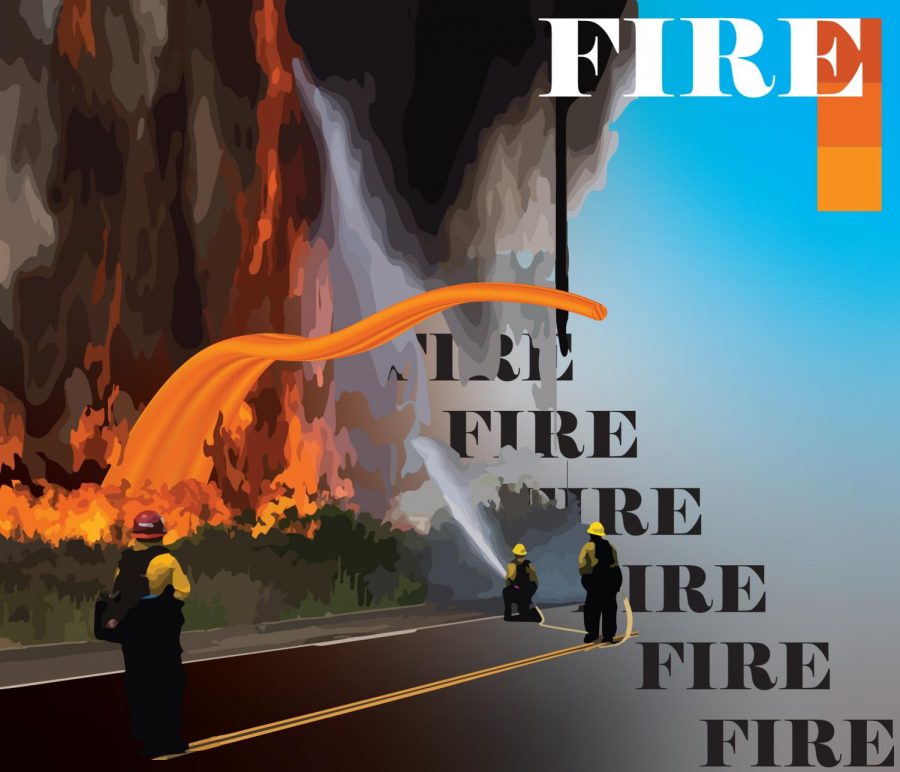California’s Flames: Northern Wildfires in the City
NEVER-ENDING SEASON A forest fire blazes in Northern California.
November 7, 2019
On Sept. 3, California’s annual wildfire season began. After just over a month, five major and individual fires have been recorded in separate areas, each burning 16,905 acres of land on average. Over tens of thousands of people are missing throughout the state, leaving a much higher number of civilians as victims to these fires, whether in the present disasters of today, or the years prior. One of these individuals is freshman Ava Divine, who lived in Berkeley, CA until she moved to Issaquah about two years ago.
“Fires are a constant problem in California,” she says, “and for any naturally dry states, for that matter. Me and my family’s home had never been in direct danger because of a wildfire, but I remember a whole neighborhood not too far from mine was under close watch for potential evacuation. One of my friends lived there.”
When looking into the location of the seven major and most recent fires, the list, according to one of the latest articles regarding the California wildfires, is as follows; the Kincade Fire, the Maria Fire, the Taboose Fire, the South Fire, the Briceburg Fire, the Cow Fire, and lastly, from CBS News, the Saddle Ridge Fire.
The Kincade Fire began on October 23, and has burned nearly 78,000 acres of land, “an area more than double the size of San Francisco,” according to NPR. The fire forced at least 180,000 people out of their homes, destroying 374 buildings. California officials declared the fire almost 80 percent contained, and should be fully under control by Thursday, November 7.
The Maria Fire, in Southern California, is also nearly contained. It burned over 9,400 acres of land, ordering evacuation of 11,000 residents. The cause of the fire is still under investigation, but is presumed to be the result of a power line burst in Ventura County.
The Taboose Fire, located ten miles southwest of Big Pine, has burned 10,296 acres of land alone. Luckily, about 75 percent of the area has been contained since the fire first began on Sept. 4. The cause is believed to be either natural or from lightning. Although the land has mostly been taken care of, the Highway 395 corridor has been temporarily blocked due to large masses of smoke and partial destruction.
The South Fire, southeast of Tomhead Mountain and west of Red Bluff, has burned a total of 5,665 acres of land. The beginning of the fire occurred on Sept. 5, because of lightning. This has become one of the most common and frequent locations for wildfires in California, often resulting in steep terrain, narrow roads, and numerous dead trees that have led to the deaths of firefighters over the years. About 67 percent of the perimeter has been secured and contained.
On Highway 140 and Briceburg Bridge Road, The Briceburg fire began on Oct. 6, burning and destroying 5,700 acres of land. Only about 15 percent of the perimeter has been contained, provoking mandatory evacuation on addresses on Highway 140 between Octagon Road, Yosemite Bug Rustic Mountain Resort, Buffalo Gulch Road and the Briceburg Campground. The cause of the fire is still unknown, but under investigation.
Within the Inyo National Rainforest of southern California, the Cow Fire started burning back on July 25. 65 percent of the perimeter still has not been contained, and it was supposedly caused by lightning in high elevation areas. However, this particular forest tends to catch fire frequently, and is expected to return to its original state. Studies show that the seasonal wildfires may even help maintain the forest’s health.
Lastly, the Saddle Ridge fire, on northern San Fernando Valley, burned 9,305 acres of land, 65 percent of which has been contained. Over 100,000 residents of 20,000 homes were evacuated. With winds at 25 miles per hour, there was one death; Aiman Elsabaggh, a Porter ranch resident at age 54. Elsabaggh passed away due to cardiac arrest while trying to protect his home from the fire. Along with Elsabaggh, a missing 89-year-old woman, Lois Arvickson, was on a phone call with her son. She told him that she was going to get her purse and leave the house, “…then the line went dead,” her son says, according to CBS. Arvickson’s neighbors reported seeing her in the garage, but they were unsure whether she was able to escape or not.
“I feel like this kind of thing has happened so often that it has become normalized,” says junior Nadeen Radi. “When in reality, we need to put a stop to it somehow. So many people lose their homes completely, and that’s what we hear about on the news. We don’t hear about what the country plans to do in order to prevent these things from happening again, which should be our primary concern for the future.”



